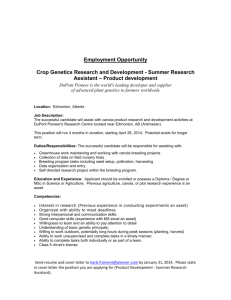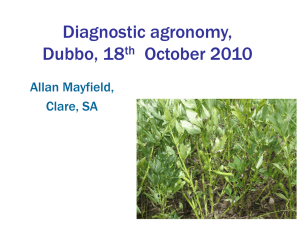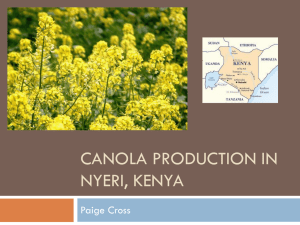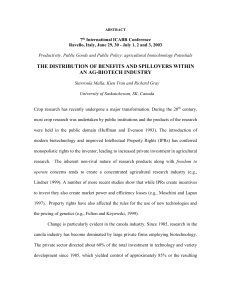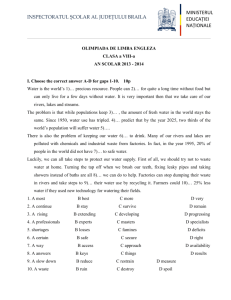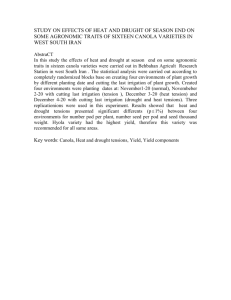PEST MANAGEMENT SUMMARY
advertisement
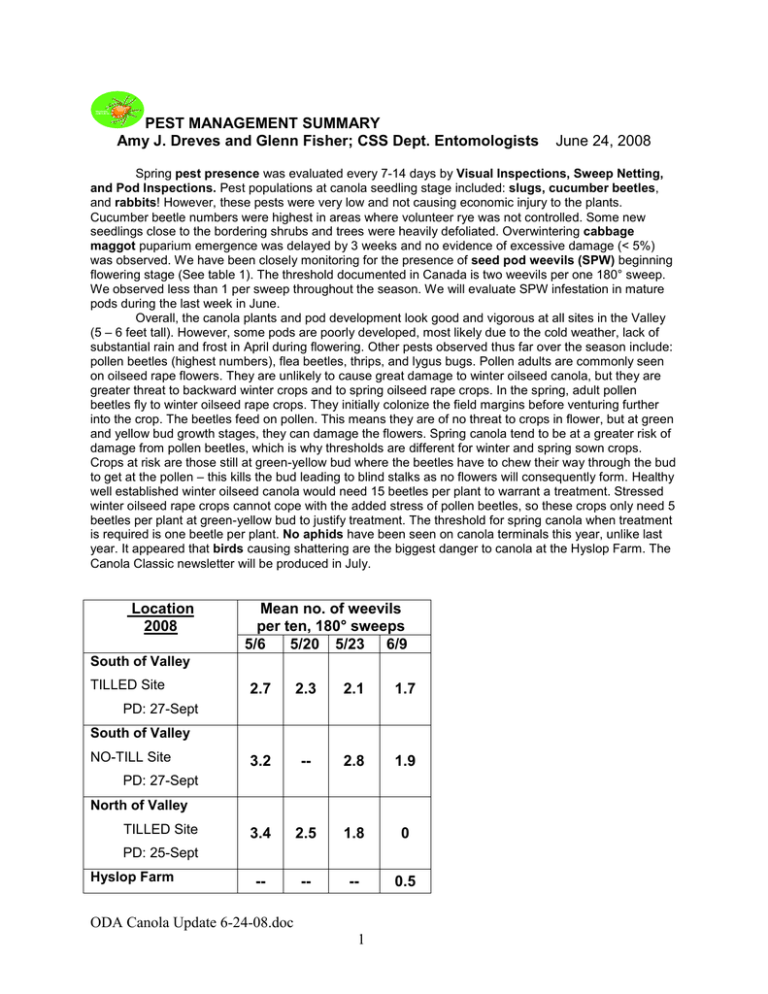
PEST MANAGEMENT SUMMARY Amy J. Dreves and Glenn Fisher; CSS Dept. Entomologists June 24, 2008 Spring pest presence was evaluated every 7-14 days by Visual Inspections, Sweep Netting, and Pod Inspections. Pest populations at canola seedling stage included: slugs, cucumber beetles, and rabbits! However, these pests were very low and not causing economic injury to the plants. Cucumber beetle numbers were highest in areas where volunteer rye was not controlled. Some new seedlings close to the bordering shrubs and trees were heavily defoliated. Overwintering cabbage maggot puparium emergence was delayed by 3 weeks and no evidence of excessive damage (< 5%) was observed. We have been closely monitoring for the presence of seed pod weevils (SPW) beginning flowering stage (See table 1). The threshold documented in Canada is two weevils per one 180° sweep. We observed less than 1 per sweep throughout the season. We will evaluate SPW infestation in mature pods during the last week in June. Overall, the canola plants and pod development look good and vigorous at all sites in the Valley (5 – 6 feet tall). However, some pods are poorly developed, most likely due to the cold weather, lack of substantial rain and frost in April during flowering. Other pests observed thus far over the season include: pollen beetles (highest numbers), flea beetles, thrips, and lygus bugs. Pollen adults are commonly seen on oilseed rape flowers. They are unlikely to cause great damage to winter oilseed canola, but they are greater threat to backward winter crops and to spring oilseed rape crops. In the spring, adult pollen beetles fly to winter oilseed rape crops. They initially colonize the field margins before venturing further into the crop. The beetles feed on pollen. This means they are of no threat to crops in flower, but at green and yellow bud growth stages, they can damage the flowers. Spring canola tend to be at a greater risk of damage from pollen beetles, which is why thresholds are different for winter and spring sown crops. Crops at risk are those still at green-yellow bud where the beetles have to chew their way through the bud to get at the pollen – this kills the bud leading to blind stalks as no flowers will consequently form. Healthy well established winter oilseed canola would need 15 beetles per plant to warrant a treatment. Stressed winter oilseed rape crops cannot cope with the added stress of pollen beetles, so these crops only need 5 beetles per plant at green-yellow bud to justify treatment. The threshold for spring canola when treatment is required is one beetle per plant. No aphids have been seen on canola terminals this year, unlike last year. It appeared that birds causing shattering are the biggest danger to canola at the Hyslop Farm. The Canola Classic newsletter will be produced in July. Location 2008 Mean no. of weevils per ten, 180° sweeps 5/6 5/20 5/23 6/9 South of Valley TILLED Site 2.7 2.3 2.1 1.7 3.2 -- 2.8 1.9 3.4 2.5 1.8 0 -- -- -- 0.5 PD: 27-Sept South of Valley NO-TILL Site PD: 27-Sept North of Valley TILLED Site PD: 25-Sept Hyslop Farm ODA Canola Update 6-24-08.doc 1 Date MAY and AUG 2007 SEPT 17, 2007 SEPT 24, 2007 JAN 9, 2008 May 28, 2008 Presentation/Talk/Newsletters Place Produced 2 CANOLA OSU Extension CLASSIC newsletters Newsletters; Crop and Soil Science Seed Pod Weevil Infestation in BILAT Canola Cooperation for R&D on cultural and biological pest control in field vegetables Canola and Root Crop Pests IOBC Working Group 'Integrated Protection in Field Crops' What’s new with Canola grown PNW Insect as a potential biofuel? Management Conference The latest pest news on Canola Hyslop Field Day in the Valley ODA Canola Update 6-24-08.doc 2 Location Oregon State Univ. Corvallis OR USA Oslo, Norway Porto, Portugal Portland, OR USA Corvallis, OR USA 6/9/08 Good and poorly-developed pods. ODA Canola Update 6-24-08.doc 3
